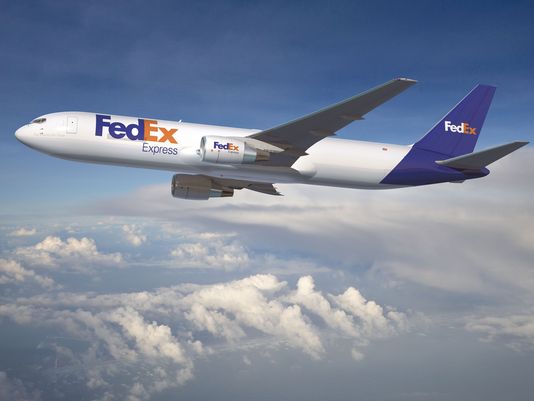FedEx Corp. plunged after cutting its profit forecast for the second straight quarter, as weak international demand hurt sales and the courier ramped up investment to handle soaring e-commerce deliveries.
The results for the company’s fiscal second quarter were “breathtakingly bad,” with weakness in both the ground-delivery unit and air-cargo business, said Deutsche Bank AG analyst Amit Mehrotra. Adjusted earnings will be no more than $11.50 a share in the fiscal year ending in May, down from the previous expectation of as much as $13, FedEx said in a statement Tuesday.

“Earnings appear to be in free fall, with seemingly little clarity being provided by management as to the duration of the current downturn and drivers of recovery,” Mehrotra said. “We’d characterize these numbers as weaker than even the most bearish estimates.”
FedEx’s crumbling outlook is piling pressure on Chief Executive Officer Fred Smith as the company contends with disruptions driven by the rise of online shopping and Amazon.com Inc. FedEx and Amazon, which is building out its own delivery network, ended most of their business ties this year. That’s weighing on FedEx’s sales, which are also suffering from weaker pricing, trade tensions and the timing of Thanksgiving in the U.S.
The shares sank 7.5% to $151.01 in early trading Wednesday. FedEx had advanced 1.2% this year through Tuesday, trailing both the 23% gain by United Parcel Service Inc. and a 27% increase for the S&P 500 Index.
While we knew fiscal 2020 would be a transition year for FedEx, there is a disconnect between management’s expectations and the market it’s operating in.
—Lee Klaskow, freight analyst
E-commerce has been squeezing profit margins at both FedEx and UPS. That’s because home deliveries are typically less profitable than drop-offs at businesses, where drivers can often leave multiple packages with a single stop.
But FedEx continues to lag in adapting to the online surge. While UPS has stabilized its margins in recent quarters, FedEx’s margins have shrunk.
Amazon Feud
FedEx was already reeling this week as its feud with Amazon intensified in the middle of the busy holiday delivery season. Citing poor service, Amazon banned third-party merchants from using FedEx’s services.
While FedEx said Amazon’s latest salvo would only affect a very modest amount of business, it acknowledged that the end of most of its business with the e-commerce giant dented sales.
Trade tensions also crimped demand from key industrial customers, FedEx said, even as the standoff between the U.S. and China has eased somewhat. FedEx has parked planes, reduced flight hours by 8% and stopped hiring pilots to match air-cargo capacity with slower international demand.
Revenue took another blow from the late timing of Thanksgiving. That gave rise to an unusually late start to the peak holiday shipping season, which got into full swing after FedEx’s fiscal second quarter ended Nov. 30. And FedEx said it underestimated the cost of moving to seven-day service.
“We’re at the bottom and we’re going to come up off the mat,” Chief Financial Officer Alan Graf said on a conference call to discuss earnings.
Margin Erosion
After adjusting for pension costs and integration expenses for the TNT Express operation in Europe, FedEx’s operating profit last quarter plummeted to 3.9% of sales from 7.5% a year earlier. That badly trailed the long-term goal of 10% operating margins.
Adjusted earnings fell to $2.51 a share, missing the $2.78 average of estimates compiled by Bloomberg. Sales slipped 2.8% to $17.3 billion.
Trip Miller, a managing partner at Gullane Capital Partners and FedEx investor, said he would stick with the company as it remakes its business for the next decade.
“When you go through a transition like FedEx is you can kind of throw all the numbers out the window,” Miller said. “They’re not going to be pretty.”
Smith called the results an anomaly because of the shortened holiday-shipping activity last quarter and the higher costs to change operations at the ground unit.
On the call with analysts, he vowed that margins at the division—which fell to 6.4% last quarter from 11.5% a year earlier—would rebound to the teens by the quarter ending in May.
“We remain highly confident in our strategies, which we believe will begin to bear fruit by our fourth fiscal quarter” he said.

Follow us on social media: